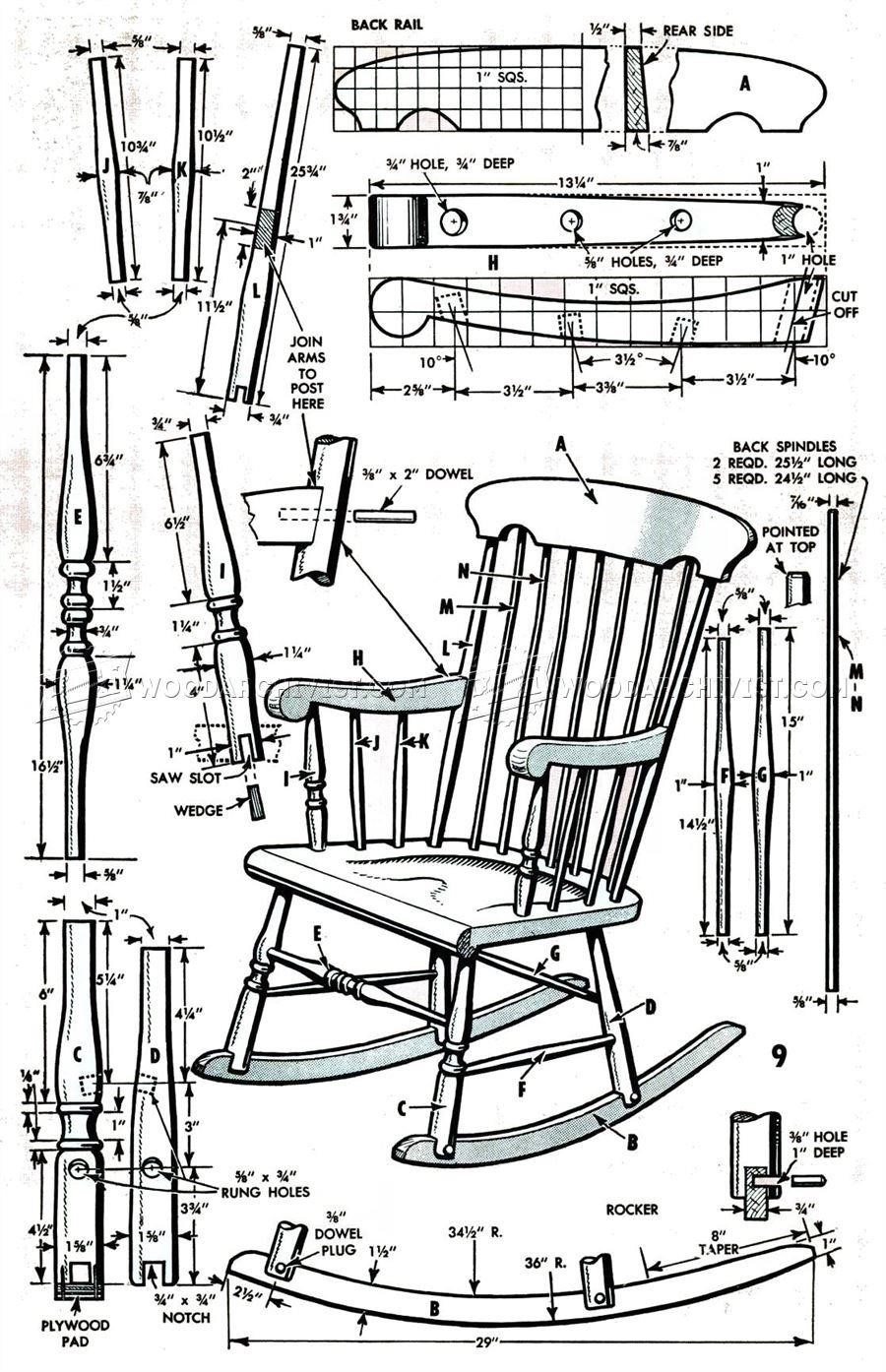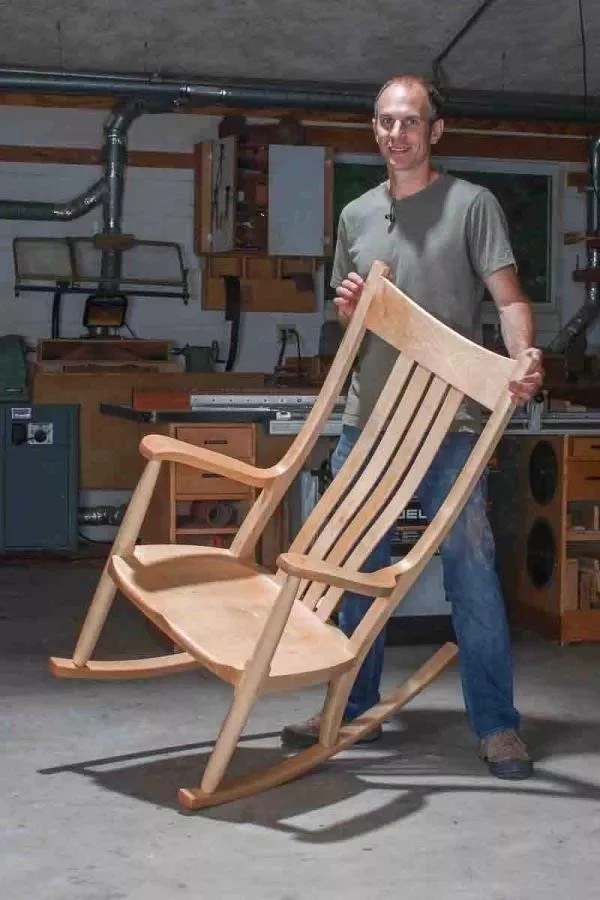Rocking Chair Plans PDF⁚ A Comprehensive Guide
This guide provides a comprehensive overview of building rocking chairs from readily available PDF plans. Discover various styles, from simple to advanced, and learn essential techniques for construction, finishing, and troubleshooting. Explore free online resources and inspiration for your project.

Finding Free Rocking Chair Plans Online
The internet offers a treasure trove of free rocking chair plans in PDF format. A quick search reveals numerous websites dedicated to woodworking projects, many offering detailed blueprints and instructions for constructing rocking chairs of varying complexity. These plans often include comprehensive materials lists, cutting diagrams, and step-by-step assembly guides, catering to both novice and experienced woodworkers. Popular online platforms like Pinterest and woodworking forums serve as excellent resources, showcasing user-submitted projects and links to free plans. Remember to carefully review each plan’s difficulty level and ensure it aligns with your skillset and available tools before embarking on your project. Some plans are specifically designed for children’s rocking chairs, while others offer more ambitious, intricate designs for adults. Always check the reviews and comments associated with a plan to gauge its accuracy and helpfulness before downloading. Be sure to preview the PDF to confirm it contains all necessary information before committing to the build.

Choosing the Right Rocking Chair Plan⁚ Styles and Difficulty Levels
Selecting the perfect rocking chair plan hinges on aligning your woodworking skills with the project’s complexity. Begin by assessing your experience level⁚ are you a beginner, intermediate, or expert woodworker? Many free PDF plans clearly indicate their difficulty level, ranging from simple designs suitable for novices to intricate projects requiring advanced techniques. Consider the style of rocking chair you envision; Adirondack chairs are known for their straightforward construction, while others, such as those with elaborate curves or intricate joinery, demand more expertise. Examine the plan’s detailed instructions, diagrams, and materials list. A well-structured plan should provide clear, concise steps, comprehensive diagrams, and a detailed list of necessary tools and materials. Pay attention to the dimensions of the chair; ensure the final product suits your intended space and user. Don’t hesitate to choose a simpler design if you’re unsure about tackling a more complex project. Remember, selecting an appropriate plan ensures a rewarding and successful building experience.
Essential Tools and Materials for Rocking Chair Construction
Before embarking on your rocking chair project, gather the necessary tools and materials. The specific requirements will vary based on the chosen plan, but some essentials remain consistent. Wood is paramount; select a durable, weather-resistant type like cedar or redwood for outdoor chairs, or a hardwood like oak or maple for indoor use. Check the plan for the specific type and dimensions of lumber needed. Essential tools include measuring tapes, pencils, saws (hand saws or circular saws), chisels, clamps, drills, screwdrivers, sanders (both belt and orbital), and woodworking planes for smoothing surfaces. Depending on the plan’s complexity, you might need specialized tools like a router or mortise and tenon jig. Always prioritize safety; wear appropriate safety glasses, ear protection, and a dust mask while working with power tools. Consider using a workbench or sawhorses for stability. Hardware is crucial; screws, dowels, wood glue, and wood filler will be necessary for assembling and finishing the chair. Finally, obtain finishing materials like stain, paint, or sealant to protect the wood and enhance its appearance. Remember to carefully review the plan’s materials list for any specific requirements before commencing your project.
Step-by-Step Guide⁚ Building a Simple Rocking Chair
Numerous websites offer free PDF plans for simple rocking chairs, perfect for beginners. These plans typically break down the construction into manageable steps, often with accompanying diagrams and illustrations. Begin by carefully reviewing the plan, understanding each component and its dimensions. Cut the wood pieces precisely according to the plan’s specifications. Accurate cutting is crucial for a stable and aesthetically pleasing chair. Next, assemble the chair’s frame, following the plan’s instructions meticulously. Use appropriate joinery techniques, such as screws, dowels, or mortise and tenon joints, to create strong connections. Ensure that all joints are properly aligned and secure before proceeding. Once the frame is complete, add the seat and back slats, ensuring even spacing and proper alignment. Use clamps to hold pieces in place while the glue dries. Sand all surfaces thoroughly to remove any imperfections or rough edges, creating a smooth finish. Finally, apply your chosen finish, allowing ample drying time between coats. Remember, patience and precision are key to successfully building a rocking chair. Take your time, double-check your measurements, and refer back to the plan as needed. Enjoy the rewarding process of creating your handcrafted rocking chair!
Advanced Techniques for Rocking Chair Building
For experienced woodworkers seeking a challenge, advanced rocking chair plans offer opportunities to explore intricate joinery and refined design elements. These plans often incorporate complex curves, sculpted details, and specialized techniques. Consider mastering steam bending to create gracefully curved chair components. This involves carefully heating wood to make it pliable, then bending it into the desired shape and securing it until it cools and sets. Alternatively, explore the use of advanced joinery methods like mortise and tenon joints reinforced with wooden pegs or through-tenons for exceptional strength and durability. Intricate shaping can be achieved through skillful use of hand tools or power tools like routers and carving tools, allowing for the creation of personalized flourishes and decorative elements. The incorporation of contrasting wood species or inlays adds visual interest and complexity. Careful planning is crucial, ensuring accurate measurements and precise execution of each step. Advanced plans may also incorporate features such as ergonomic designs for optimal comfort or specialized rocking mechanisms for a unique rocking experience. These techniques demand precision and patience, but the result is a stunning, handcrafted rocking chair that showcases your woodworking expertise.
Customizing Your Rocking Chair⁚ Design and Dimensions
Once you’ve chosen your rocking chair plan, the possibilities for customization are vast. Begin by considering the overall dimensions. Adjust the seat height to suit your comfort level, ensuring proper legroom and a comfortable posture. Modify the seat depth and width to accommodate your body size. The rocking curve itself is a key design element; a gentler curve provides a slower, more subtle rocking motion, while a more pronounced curve offers a more vigorous rocking experience. Experiment with different back styles; consider a high back for added support and headrest, or a lower back for a more open and airy feel. The armrests can be adjusted in height and width for optimum comfort and support. Incorporate personal touches by altering the shape and size of the legs or adding decorative elements such as spindles, carvings, or inlays. Consider using different wood types to create a unique aesthetic; contrasting colors and grain patterns can enhance the chair’s visual appeal. You can also adjust the angle of the rockers to fine-tune the rocking motion. Before making significant changes, create detailed sketches or use digital design tools to visualize the modifications and ensure they maintain structural integrity. Remember to always adjust dimensions proportionally to maintain balance and avoid compromising stability. The final result should be a unique rocking chair perfectly tailored to your preferences and needs.
Safety Precautions During Construction
Building a rocking chair involves working with woodworking tools and materials, so prioritizing safety is paramount. Always wear appropriate safety glasses or a face shield to protect your eyes from flying debris. Hearing protection is also essential, especially when using power tools like saws and sanders. Ensure your workspace is well-lit and free from clutter to prevent tripping hazards. Use clamps to secure your workpieces firmly in place before cutting or drilling to prevent accidental slippage. When using power tools, always operate them according to the manufacturer’s instructions and maintain a firm grip. Never reach across a moving blade. Take breaks to avoid fatigue, as fatigue can lead to mistakes and accidents. Wear work gloves to protect your hands from splinters and cuts. If using chemical finishes, work in a well-ventilated area and wear a respirator to avoid inhaling harmful fumes. Follow the instructions on the finish product carefully. Dispose of all waste materials properly and responsibly. Always keep children and pets away from the workspace while you are using power tools or handling sharp objects. Remember, careful planning and adherence to safety guidelines are essential for a successful and injury-free project. Double-check your measurements and plans before cutting any wood to minimize mistakes and avoid wasting materials.
Finishing Your Rocking Chair⁚ Staining, Painting, and Sealing
Once your rocking chair is assembled, the finishing touches significantly impact its durability and aesthetic appeal. Begin by sanding all surfaces smooth, using progressively finer grits of sandpaper to achieve a flawless finish. Remove all sanding dust with a tack cloth before applying any stain or paint. If using a stain, choose a color that complements your décor and apply it evenly according to the manufacturer’s instructions. Multiple thin coats are generally better than one thick coat to prevent uneven absorption and dripping. Allow ample drying time between coats. For a painted finish, prime the wood first with a high-quality primer to ensure even paint coverage and adhesion. Apply several coats of paint, allowing each coat to dry completely before applying the next. Consider using a sealant to protect the finish from moisture and wear. A clear polyurethane sealer is a popular choice and provides a durable, protective layer. Apply the sealer in thin coats, allowing each coat to dry thoroughly. For a more rustic look, consider using a natural oil finish, like tung oil or linseed oil. These oils penetrate the wood, enhancing its natural beauty and providing some protection against moisture. Remember to always work in a well-ventilated area and wear appropriate safety gear when applying finishes. Proper finishing techniques will protect your rocking chair and add to its longevity and beauty, ensuring years of comfortable enjoyment. A well-finished rocking chair will be a source of pride and a cherished addition to your home.
Troubleshooting Common Rocking Chair Building Problems
Building a rocking chair, even with detailed plans, can present challenges. One common issue is uneven rocking. This often stems from discrepancies in leg length or rocker curvature. Carefully double-check measurements throughout the construction process, and use a level to ensure all components are perfectly aligned. If the chair rocks unevenly after assembly, identify the high leg and carefully plane it down until the rocking motion is smooth and consistent. Another problem is loose joints. Prevent this by using appropriate wood glue and ensuring proper screw placement. Pre-drilling pilot holes before screwing can prevent wood splitting. If joints become loose after assembly, consider reinforcing them with additional wood glue or wood screws. A wobbly chair usually indicates insufficient support or improperly fitted joints. Check all joints for tightness. If the seat feels unstable, reinforce the seat supports or adjust their placement. Remember, accurate measurements and careful attention to detail are crucial. If you encounter significant difficulties, consult online forums or woodworking communities for advice. Many experienced woodworkers are willing to share their expertise and assist with problem-solving. Detailed photos of the problem area can aid in receiving accurate solutions. Don’t be discouraged by setbacks; perseverance and troubleshooting skills are essential in woodworking.
Resources for Further Learning and Inspiration
Numerous online and offline resources can enhance your rocking chair building journey. Websites specializing in woodworking plans, such as those mentioned in the provided text snippets, offer a wealth of free and paid plans, ranging in complexity and style; Explore platforms like Pinterest and other social media for visual inspiration, showcasing various rocking chair designs and construction techniques. Consider joining online woodworking communities and forums. These platforms provide opportunities to connect with experienced craftspeople, ask questions, and share your progress. Many experienced woodworkers are happy to offer guidance and support. Don’t hesitate to seek advice on specific challenges or techniques. Local libraries often carry books on woodworking, including detailed guides on chair construction. These books provide valuable insights into joinery techniques, wood selection, and finishing processes, offering a deeper understanding of the craft. Woodworking magazines and publications often feature articles on chair building, offering step-by-step instructions, tips, and tricks from experienced artisans. YouTube channels dedicated to woodworking offer video tutorials, demonstrating various aspects of chair construction, from planning and cutting to assembly and finishing. Exploring these diverse resources will equip you with the knowledge and inspiration to create a beautiful and functional rocking chair.

